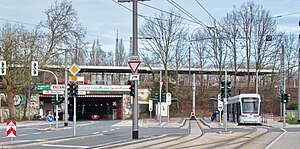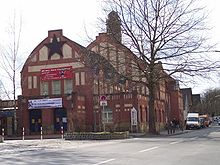Bochum-Langendreer train station
| Bochum-Langendreer train station | |
|---|---|
|
Bochum-Langendreer stop
|
|
| Data | |
| Design | Through station |
| Platform tracks | 2 |
| abbreviation | EBLA (freight yard) EBP (S-Bahn stop) |
| IBNR | 8000358 |
| Price range | 4th |
| Profile on Bahnhof.de | Bochum-Langendreer |
| location | |
| City / municipality | Bochum |
| country | North Rhine-Westphalia |
| Country | Germany |
| Coordinates | 51 ° 28 ′ 40 " N , 7 ° 18 ′ 50" E |
| Railway lines | |
| Railway stations in North Rhine-Westphalia | |
The Bochum-Langendreer station is now a breakpoint of the Rhine-Ruhr S-Bahn in the district of Langendreer in the east of Bochum with the ground internal abbreviation EBP . The 40-hectare marshalling yard in Langendreer, which previously existed in Langendreer, is now used as an operating and transfer station, the internal abbreviation of which is EBLA . Until the 1980s, Langendreer was the location of a passenger station , where express trains on the Ruhr area – Siegen – Frankfurt route also stopped.
history
The Bergisch-Märkische Eisenbahn-Gesellschaft (BME) opened the first train station in Langendreer on October 26, 1860 as the provisional end point of their route coming from Witten Hauptbahnhof . In 1862 connections to Dortmund and Duisburg went into operation, which are still part of the Witten / Dortmund – Oberhausen / Duisburg railway line and are one of the most important and busiest routes in Germany. Also in 1862 the line to Laer was opened, on which initially only coal trains from the Dannenbaum colliery ran. With the extension to Dahlhausen in 1870, regular freight trains also ran here.
The BME train station was located quite far from the center of Langendreer at that time, roughly in the area of what is now the Langendreer West stop. The interests of freight traffic were decisive, especially the proximity to mines such as Mansfeld , Vollmond or Neu-Iserlohn , while passenger traffic was only of subordinate importance. As a hub in the BME network, the station was equipped with a larger reception building and extensive goods sheds; a rectangular locomotive shed with a turntable and water tower was built north of the railway site on Gasstrasse . In 1874 the BME built a small marshalling yard, which was continuously expanded in the following years.
On November 19, 1874, the Rheinische Eisenbahn-Gesellschaft opened another train station in Langendreer, which was located to the east of the BME train station, around what is now the cultural center of Langendreer train station. This six-track through station was on the north of the BME lines from Bochum north to Dortmund south .
The relationship between the two railway companies was characterized by fierce competition, which was evident, for example, in the dispute over the connection of the Siebenplaneten colliery . This colliery was connected to both lines in 1877. In December 1880 the Rheinische Eisenbahn-Gesellschaft opened a branch line to Löttringhausen .
Both the Bergisch-Märkische Eisenbahn-Gesellschaft and the Rheinische Eisenbahn-Gesellschaft came into the possession of the Prussian State Railway through nationalization , which renamed the stations "Langendreer-Süd" and "Langendreer-Nord". At the beginning of the 20th century, further increases in traffic led to a fundamental redesign of the railway facilities in Langendreer, where passenger and freight traffic were given separate tracks.
From 1906, a new, two-sided marshalling yard was built for freight traffic, and six platform tracks were built for passenger traffic in the area of Langendreer-Nord station. The 1907 and 1908 built station building was designed by the architect Schlomeyer and consists of three building structures in the Art Nouveau style with Wölbdächern . The choice of the station location in a sparsely developed area met with rejection from the population; In the meantime, residential buildings had developed in the area of the abandoned Südbahnhof.
When Langendreer was incorporated into Bochum on August 1, 1929, the station was renamed "Bochum-Langendreer". During the Weimar Republic, the line to Bochum was expanded to four tracks, and Langendreer also became a stop for the Ruhr express traffic . During the Second World War, the station was only slightly damaged compared to stations of a similar size.
Due to the death of collieries , the volume of goods traffic fell drastically in the 1950s. The western drainage mountain was shut down in 1962, and the trains previously formed here were now put together in Bochum-Dahlhausen and Wanne-Eickel . The establishment of two Opel plants in Bochum determined the appearance of freight trains in Langendreer from 1962: In addition to shipping brand-new cars, semi-finished products are transported by rail within the General Motor Group . A container terminal opened in 1967 was shut down again in 2000.
In the 1970s, passenger train traffic was restricted on the branch lines starting from Langendreer; for example, two pairs of trains still ran on the route to Dortmund-Löttringhausen in the 1976 summer timetable. In 1982, Langendreer was given up as an express train stop ( D-Zug Oberhausen – Hagen – Siegen – Frankfurt), and ticket issuance closed the following year. Since September 1983, the S-Bahn line S 1 of the S-Bahn Rhein-Ruhr has been running from Bochum via Langendreer to Dortmund, the newly built S-Bahn line runs in the south of the freight tracks, while the old line with the station is in the north. With the opening of the S-Bahn line with the two new stops “Langendreer West” and “Langendreer”, the passenger station was shut down. This also gave up direct passenger traffic towards Witten. In 1985 an initiative saved the reception building from demolition. It was placed under monument protection, extensively renovated and reopened in 1986 as the Kulturzentrum Bahnhof-Langendreer ( Kulturbahnhof ) .
Operations on the east-west system of the marshalling yard ceased in summer 1998. In the present (2019), these parts of the marshalling yard are operational.
service
The Langendreer stop has two tracks on a central platform. Both are intended for regular S-Bahn traffic.
| line | Line course | Tact |
|---|---|---|
| S 1 |
Solingen Hbf |
20 min SG-DU 30 min DU-E 15 min E-DO |
Tram lines 302, 305 and 309 have their final stop here.
Line 302 comes from Gelsenkirchen-Buer , line 305 from Bochum- Höntrop and line 309 from Witten- Heven .
Line 309 will not go into operation in Langendreer until autumn 2020 (probably September).
The bus lines 369 (on behalf of BOGESTRA), 378, 379 and the NachtExpress lines NE 3 and NE 18 also serve this stop.
All of these lines are operated by BOGESTRA .
future
With the completion of the new tram line of line 310 to Witten announced for 2019, further lines from Bochum or from Langendreer train station will lead via Langendreer Markt to Witten from the end of 2019. On this date, the basic cycle of the Rhine-Ruhr S-Bahn and thus also the S 1 S-Bahn line will be changed across cities. Both are reasons for a major redesign of the bus network in Langendreer and beyond, especially with regard to the connection to the Ruhr University Bochum .
In connection with the Rhein-Ruhr-Express , the regional train and regional express lines from Essen via Bochum to Witten and further via Hagen to Siegen are no longer to be run over the long-distance railway tracks near the Bahnhof-Langendreer cultural center , but instead use the S-Bahn line. The necessary modifications would again enable direct passenger traffic from Langendreer to Witten.
Web links
- Tracks in service facilities (EBLA) , DB Netz AG (PDF; 210 KiB)
- Description of the EBLA operating point in the NRWbahnarchiv by André Joost
- Description of this sight on the route of industrial culture
Individual evidence
- ↑ Jörg Hajt: Railways in the Ruhr Area . On the history of the station. Kenning, Nordhorn 1994, ISBN 3-927587-19-2 , pp. 72-76 .
- ↑ Langendreer station. In: route-industriekultur.de. Retrieved August 26, 2017 .
- ↑ http://tramtracks.de/bochum_langendreer_nord.htm ( page no longer available , search in web archives ) Info: The link was automatically marked as defective. Please check the link according to the instructions and then remove this notice. Pictures of the station forecourt
- ^ Rolf Swoboda, Harald Vogelsang, Wolfgang Klee: The railway in Bochum . DGEG Medien, Hövelhof 2007, ISBN 978-3-937189-28-4 , p. 52 .
- ↑ Line 310.BOGESTRA AG, accessed on August 25, 2017 .
- ^ Local public transport in Bochum. Press office of the city of Bochum, accessed on August 25, 2017 .




